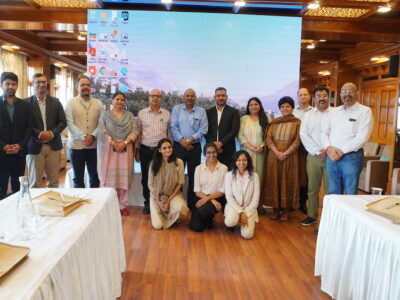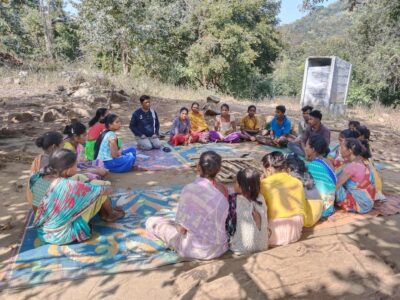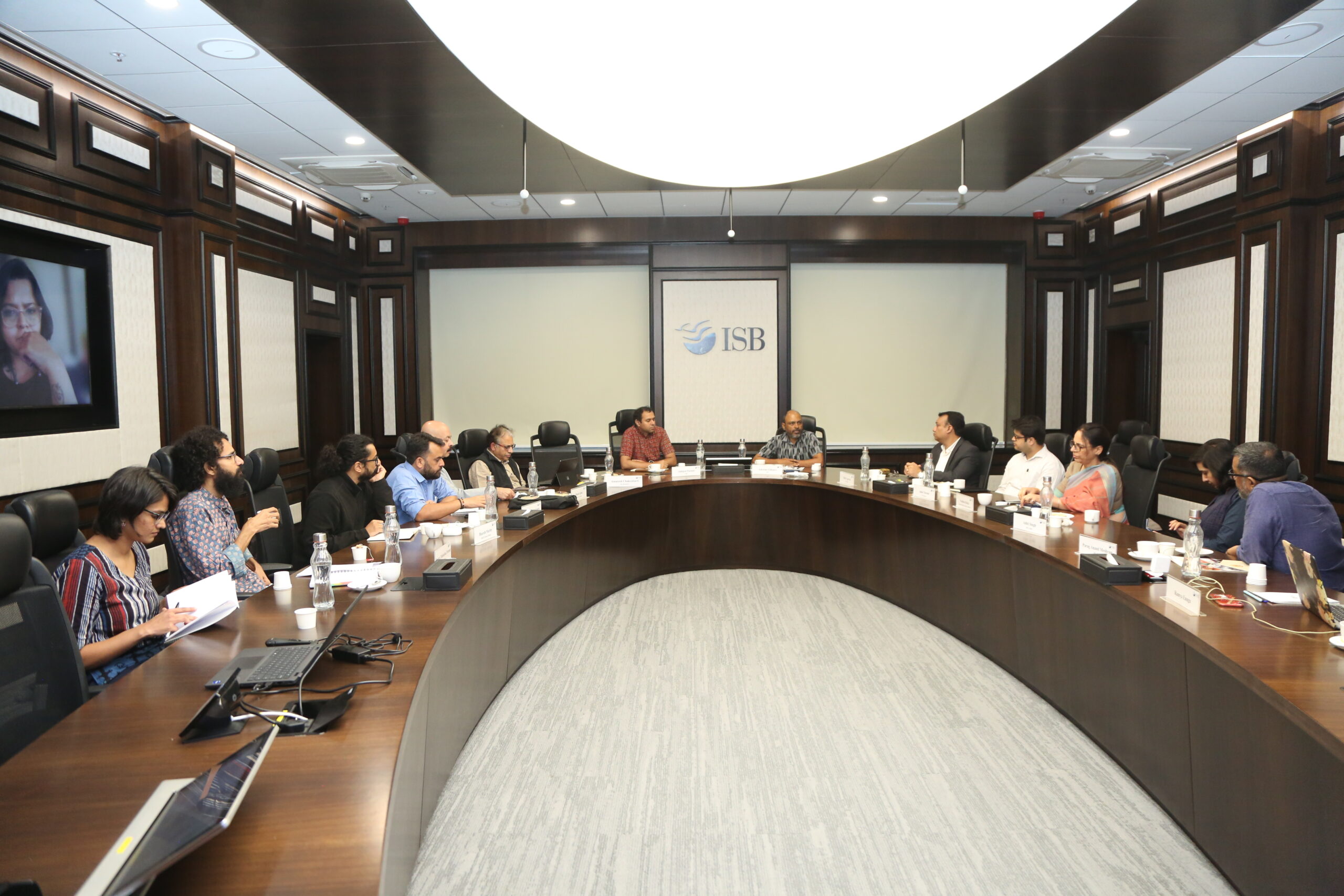Roundtable on Forests as Sustainable and Secure Energy and Fossil Fuel Substitutes

The vision of Initiative on Forest Economy at BIPP-ISB primarily aims at creating a model for environmentally responsible and efficient forest management on a large scale. We believe that this model drives long-term economic growth and stability by generating profits. To build on this vision, ISB-BIPP held a four-day roundtable discussion, inviting representatives from the energy and fossil fuel, technology, design and communication, and finance sectors to attend. The purpose of the discussion was to gain insight into the specific challenges faced by each industry, explore potential solutions, and identify opportunities for success in a business model based on Seasonal Forest Products (SFP) and Community Forest Resource (CFR) rights.
By incorporating forest resources into supply and value chains through establishing women-led community owned enterprises, ecologically beneficial sustainable forest management can be achieved. Enhanced communication and coordination facilitated by technology improvements can help governments and corporations collaborate to protect and regenerate forests while improving communities’ living conditions and economic opportunities. A forest economy could have a significant impact on the future economy.
The model is built on three fundamental tenets: security of tenure, technology integration for operational efficiency and effectiveness, and community-based enterprises. By incentivising communities through legally secured tenured of forest resources to manage forests, deforestation and resource exploitation can be prevented. Establishing community owned businesses, we enable a legal, long-term business model while developing forest conservation practices to manage forest resources sustainably. Women-led enterprises owned by communities with CFR titles supply affordable raw materials directly to companies, providing an incentive to protect forests. The government’s involvement ensures that partnerships are supervised and financially supported. The use of technology, such as satellite photography and GPS, can improve communication and ensure responsible resource utilization. Community-based enterprises, where local people are involved in management and profitability, can both protect forests and provide economic benefits.
BIPP-ISB is currently piloting the forest economy model in in Himachal Pradesh, Orissa, and Jharkhand to assess its feasibility and identify any challenges or barriers to implementation. The objective is to establish a system that drives economic growth and sustainability through profit by collaborating with relevant government agencies and establishing community firms with links to industries.
On the first day of the roundtable, senior representatives from Craste, Birla Century, Biofuel Circle, BPCL, VICAT-Bharti Cement, Shree Cement, Vedanta, and Sai Wardha discussed “Forests as Sustainable and Secure Energy and Fossil Fuel Substitutes”, a key aspect of the forest economy vision.” The discussions shed light on the challenges faced by these industries and potential solutions to make the forest-based economy business model successful. To establish a sustainable model for obtaining raw materials to generate alternative fuel from forests through the agency of Community Forest Rights, which is currently being piloted by BIPP-ISB, it is crucial to provide contextual responses to the issues raised during the roundtable discussions. BIPP-ISB opened the discussions by asserting that India’s forests have faced severe degradation and exploitation in recent decades due to a lack of sustainable growth incentives and poor management practices. As a result, important forest benefits such as carbon sequestration, water management, and wildlife habitat have been lost. Energy production is a major demand, and it is expected to continue to grow, making and finding alternatives to fossil fuels is a priority. To sustainably manage forests, we need to incorporate technology and mechanization.
Senior level industry representatives highlighted issues that must be addressed for a seasonal forest product-based business strategy to be successful. The representative of Vedanta discussed aspects such as reducing the carbon footprints of products on the market, developing solutions for energy scarcity, transitioning from fossil fuels to non-fossil fuels, and establishing an ecosystem for renewable energy.
Representatives of the industry have identified key issues that must be addressed for a successful forest economy strategy. These include reducing carbon footprints, transitioning from fossil fuels to non-fossil fuels, and creating a renewable energy ecosystem. The government’s reluctance to support the forest economy due to concerns of biomass degradation was noted, and improved communication between industries and government was suggested as a solution. Trust building exercises like spending profit share on forest regeneration can accentuate such partnerships.
One suggested solution to promote the use of forest biomass by industries was the idea of governments offering subsidies to support their efforts.
The representative from Craste and VICAT -Bharti cement highlighted that implementing this strategy faces several challenges, including exorbitant transportation costs and inconsistent quantity of raw material supply. Additionally, forests are often located in unfavourable or remote areas to the industries, making harvesting and transporting seasonal forest products time-consuming and expensive.
Decentralized factories run by farmer organizations at the local level can improve the rural economy, create jobs, and reduce urban migration. Other challenges include the cost of collection, storage, and access to raw materials, as well as adding value to raw resources through technology. For example, pine needles, rich in cellulose and lignin, can be utilized in paper and packaging industries or to create cost-effective alternatives to plywood. A one-hectare land can produce three tonnes of pine needles, but one acre of land can produce three tonnes of crop stubble. Therefore, agricultural stubble extraction costs are smaller than pine needles. Pine needle yield per hectare is a factor that must be considered. In addition, the utilization of raw resources in the production of the best products is vital. As an alternative to generating briquettes from pine needles, furniture might be manufactured as a cost-effective choice with more customer incentives. Technology must be used to comprehend the various raw materials to determine how they may be utilized most effectively by adding value-added applications. Cashew nut shells, ground nut shells, and sawdust can also be used as alternative fossil fuels. However, a proper supply chain is necessary to provide a continuous, large-scale supply for these products.
The industry representative from Craste asserted that technology must be utilised to comprehend the properties of various raw materials to determine the optimal value-adding application. The issue of competitive pricing will exacerbate the problem of buyer/industry exploitation of raw material costs.
The lack of a fixed price and legal regulations for seasonal forest products also exacerbates exploitable raw material costs by buyers/industries. There is a need for new strategies that rely on profitable operations instead of charitable contributions. Regulating and encouraging collaborations between government, industries, and local communities is essential to ensure the model’s sustainability and profitability for all parties involved.
The representative from Shree Cement highlighted the importance of using seasonal forest products in value-added applications. They suggested that incentives, such as using sustainable materials like pine-needle-based boards to reduce carbon emissions, could be increased. The representative also proposed government transportation subsidies as a way to encourage the use of forest products as raw materials. In conclusion, the importance of technological innovation was emphasized. In conclusion, the need for innovative technological interventions was emphasised.
The industry representative from BPCL discussed Ethanol, biodiesel, and compressed biogas issues. Transportation costs, long-term storage costs, and maintaining quality supply in large quantities of ethanol were cited as some of the challenges that need to be resolved in order to source ethanol. The representative suggested that government support for floating ethanol plants, mapping resources with the industry, and an economic model with all the information readily available for the industry to plan its production and procurement sources can solve a variety of issues.
Industry insiders expressed concern over the difficulties they face in utilising bamboo and the high transportation costs that discourage sourcing bamboo from forests. Professor Ashwini Chhatre informed them about the innovative bamboo exploder machine developed by the IIT Madras team as a potential solution to the bamboo transportation cost issues. He assured of the efforts being made to find solutions to the problems, and importance of everyone’s participation.
Despite the need to address these issues, a sustainable forest economy could yield substantial benefits. The preservation and regeneration of forests will aid in the fight against climate change and the preservation of biodiversity. The emergence of local enterprises and the integration of resources into supply networks can yield economic benefits for businesses and forest resource-based communities. To ensure that future generations continue to receive these benefits from forests, we must incentivize their protection and regeneration.
India stands to gain enormously from the development of a sustainable forest economy. Combining tenure security, technology, and local businesses enables our strategy to be both ecologically and economically beneficial. Nonetheless, there are obstacles that can be overcome with the government, businesses, and communities collaborating to find solutions. If we make the necessary efforts now, we can ensure that forests are valued and preserved for all the benefits they will provide in the future.



